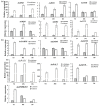Profiling of Volatile Compounds and Associated Gene Expression in Two Anthurium Cultivars and Their F1 Hybrid Progenies
- PMID: 34068329
- PMCID: PMC8153298
- DOI: 10.3390/molecules26102902
Profiling of Volatile Compounds and Associated Gene Expression in Two Anthurium Cultivars and Their F1 Hybrid Progenies
Abstract
Anthurium is an important ornamental crop in the world market and its floral scent can enhance its ornamental value. To date, studies of the components and formation mechanism of the floral scent of Anthurium are relatively few. In this study, the scent profiles of two Anthurium varieties were measured by gas chromatograph-mass spectrometer (GC-MS). There were 32 volatile organic compounds (VOCs) identified in Anthurium 'Mystral', and the most abundant compound was eucalyptol (57.5%). Extremely small amounts of VOCs were detected in Anthurium 'Alabama'. Compared with A. 'Alabama', most genes related to floral scent synthesis exhibited a higher expression in A.'Mystral', including AaDXS, AaDXR, AaMDS, AaHDS, AaTPS, AaDAHPS, AaADT2, AaPAL1, and AaPAL2. In order to produce new varieties of Anthurium with fragrance, 454 progenies of two crossbred combinations of A. 'Mystral' and A. 'Alabama' were obtained. Four F1 generation plants with different floral scent intensities were selected for further study. The major components of floral scent in the progenies were similar to that of the parental A.'Mystral' plant. The expression patterns of genes related to floral scent synthesis were consistent with the relative contents of different types of VOCs. This study revealed the profiles of volatile compounds and associated gene expression in two Anthurium cultivars and their F1 hybrids, which provided a basis for the floral scent inheritance of Anthurium andraeanum.
Keywords: Anthurium andraeanum; VOCs; floral scent; gene expression; hybrid progenies.
Conflict of interest statement
The authors declare no conflict of interest.
Figures




Similar articles
-
Composition and Biosynthesis of Scent Compounds from Sterile Flowers of an Ornamental Plant Clematis florida cv. 'Kaiser'.Molecules. 2020 Apr 8;25(7):1711. doi: 10.3390/molecules25071711. Molecules. 2020. PMID: 32276485 Free PMC article.
-
Identification of Floral Scent Profiles in Bearded Irises.Molecules. 2019 May 7;24(9):1773. doi: 10.3390/molecules24091773. Molecules. 2019. PMID: 31067789 Free PMC article.
-
Evolution and diversity of floral scent chemistry in the euglossine bee-pollinated orchid genus Gongora.Ann Bot. 2016 Jul;118(1):135-48. doi: 10.1093/aob/mcw072. Epub 2016 May 30. Ann Bot. 2016. PMID: 27240855 Free PMC article.
-
The Scent of Lily Flowers: Advances in the Identification, Biosynthesis, and Regulation of Fragrance Components.Int J Mol Sci. 2025 Jan 8;26(2):468. doi: 10.3390/ijms26020468. Int J Mol Sci. 2025. PMID: 39859184 Free PMC article. Review.
-
Volatile Organic Compounds from Orchids: From Synthesis and Function to Gene Regulation.Int J Mol Sci. 2020 Feb 10;21(3):1160. doi: 10.3390/ijms21031160. Int J Mol Sci. 2020. PMID: 32050562 Free PMC article. Review.
Cited by
-
Chromosome-level genome assembly and annotation of Anthurium amnicola.Sci Data. 2025 Apr 10;12(1):605. doi: 10.1038/s41597-025-04939-4. Sci Data. 2025. PMID: 40210919 Free PMC article.
-
Transcriptomic and metabolomic data reveal key genes that are involved in the phenylpropanoid pathway and regulate the floral fragrance of Rhododendron fortunei.BMC Plant Biol. 2023 Jan 5;23(1):8. doi: 10.1186/s12870-022-04016-7. BMC Plant Biol. 2023. PMID: 36600207 Free PMC article.
-
Molecular and metabolic insights into floral scent biosynthesis during flowering in Dendrobium chrysotoxum.Front Plant Sci. 2022 Nov 28;13:1030492. doi: 10.3389/fpls.2022.1030492. eCollection 2022. Front Plant Sci. 2022. PMID: 36518498 Free PMC article.
-
HS-SPME-GC-MS and Electronic Nose Reveal Differences in the Volatile Profiles of Hedychium Flowers.Molecules. 2021 Sep 6;26(17):5425. doi: 10.3390/molecules26175425. Molecules. 2021. PMID: 34500858 Free PMC article.
-
Floral scent of artificial hybrids between two Schiedea species that share a moth pollinator.Am J Bot. 2025 Jul;112(7):e70065. doi: 10.1002/ajb2.70065. Epub 2025 Jun 29. Am J Bot. 2025. PMID: 40583235 Free PMC article.
References
-
- Kishimoto K., Nakayama M., Yagi M., Onozaki T., Oyama-Okubo N. Evaluation of wild Dianthus species as genetic resources for fragrant carnation breeding based on their floral scent composition. J. Jpn. Soc. Hortic. Sci. 2011;80:175–181. doi: 10.2503/jjshs1.80.175. - DOI
MeSH terms
Substances
Grants and funding
LinkOut - more resources
Full Text Sources
Miscellaneous

